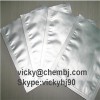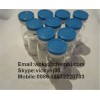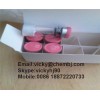1. Quick Details:
Product name: Cabergoline
Synonyms: 6-Allyl-N-[3-(dimethylamino)propyl]-N-(ethylcarbamoyl)ergoline-8-carboxamide
Assay: 98.5-102.0%
CAS: 281409-90-7
Molecular formula: C26H37N5O2
Molecular weight: 451.60
Packing: Standard
Package: 1g/foil bag
Storage and Transport conditions Sealed in shade ( +2-+8 °C)
Usage: Treatment of hyperprolactinemia, either idiopathic or due to pituitary adenomas. Investigational: Shrink tumors in clients with microprolactinoma or macroprolactinoma. Parkinson's disease. Normalize androgen levels and improve menstrual cyclicity in polycystic ovary syndrome.
2. Product Description:
Cabergoline was first synthesized by scientists working for the Italian drug company Farmitalia-Carlo Erba SpA in Milan in 1981/82,[2] who were experimenting with semisynthetic derivatives of the ergot alkaloids.
Cabergoline is a long-acting dopamine D2 receptor agonist and in vitro rat studies show a direct inhibitory effect on the prolactin secretion in the pituitary's lactotroph cells. Cabergoline decreased serum prolactin levels in reserpinized rats.
Receptor binding studies indicate a low affinity for dopamine D1 receptors, α1-adrenergic receptors, and α2-adrenergic receptors.
3. Application:
1. hyperprolactinemia
2. adjunctive therapy of prolactin-producing pituitary gland tumors (prolactinomas);
3. monotherapy of Parkinson's disease in the early phase;
4. combination therapy, together with levodopa and a decarboxylase inhibitor such as carbidopa, in progressive-phase Parkinson's disease;
5. in some countries also: ablactation and dysfunctions associated with hyperprolactinemia (amenorrhea, oligomenorrhea, anovulation, nonpuerperal mastitis and galactorrhea);
6. treatment of uterine fibroids.
7. adjunctive therapy of acromegaly, cabergoline has low efficacy in suppressing growth hormone levels and is highly efficient in suppressing hyperprolactinemia that is present in 20-30% of acromegaly cases; growth hormone and prolactin are similar structurally and have similar effects in many target tissues, therefore targeting prolactin may help symptoms when growth hormone secretion can not be sufficiently controlled by other methods;
8. Cushing's disease - cabergoline may be used to lower ACTH levels and cause regression of ACTH producing pituitary adenomas;
9. other pituitary adenomas - cabergoline has demonstrated certain efficacy in controlling or reducing other kinds of pituitary adenomas, as well as silent or non-functional adenomas.














